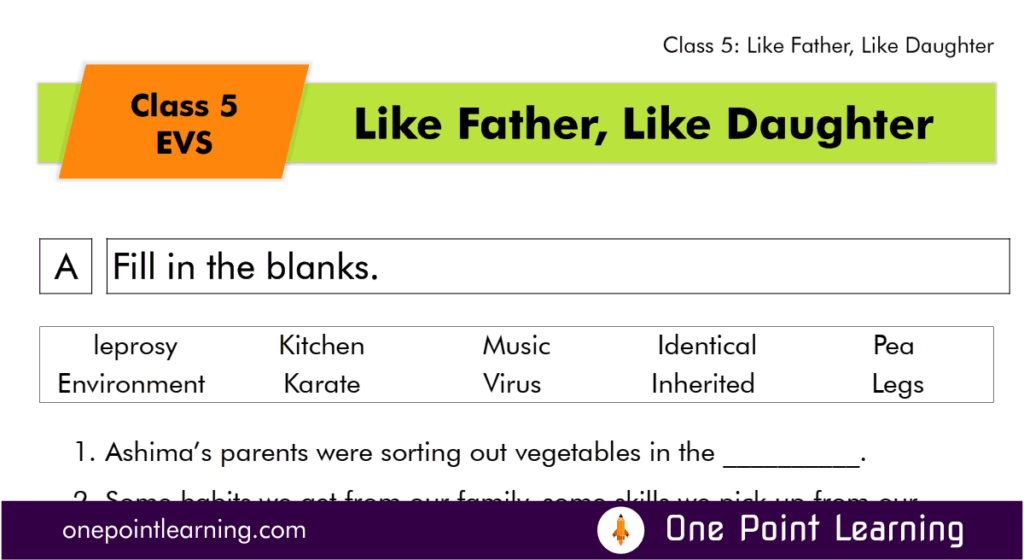NCERT Class 5 EVS Chapter 21 Like Father Like Daughter, explores the complex concept of inheritance and individual development.
The chapter revolves around the similarities and differences that exist within families and beyond. The chapter explores the fascinating concept of inheritance.
In this chapter, we learn how children can inherit physical features and some habits from their parents. But it’s important to remember that our environment and individual choices also play a crucial role in shaping who we become.
Saroja and Suvasini, despite their shared genes, develop unique personalities and skills due to their different surroundings and personal pursuits.
Also, not all resemblances are genetic, and not every difference stems from inheritance. The chapter also underlines the importance of respecting people, regardless of their similarities or differences. We learn that everyone is unique, shaped by a blend of inherited traits, environmental influences, and individual choices.
Moreover, the chapter also focuses on the polio disease caused by the virus and how it affects one’s life.
Key Points:
- Children inherit some physical features and habits from their parents.
- Environment and individual choices also shape our skills and personalities.
- People can be similar in some ways and different in others, even within families.
Our Like Father Like Daughter Class 5 Worksheet with answers helps students to understand the topic in a simple and easy way.
Also, do not forget to download our free printable Class 5 EVS Chapter 21 Solutions PDF.
Chapter 21 Like Father Like Daughter

We are now on WhatsApp – Click to Join Us
Also Download:
Class 5 EVS Worksheets
Hindi Worksheet for Class 5
Maths Worksheet for Class 5
Class 5 EVS Chapter 21 Extra Questions
Q1. What is polio? How can it be prevented?
Ans. Polio is a highly infectious viral disease that can cause paralysis, often in the legs. Symptoms include fever, fatigue, vomiting, muscle weakness, and paralysis. Polio is prevented through vaccination with the polio vaccine, which is safe and effective.
Q2. Why does Saroja’s mama get confused when he sees Saroja and Suvasini together?
Ans. Saroja’s mama gets confused because Saroja and Suvasini are twins and look very similar.
Q3. How are Saroja and Suvasini different from each other?
Ans. Saroja knows two languages (Tamil and Marathi) while Suvasini’s family speaks only one language (Kashmiri). Saroja also likes music, while Suvasini does karate.
Q4. Where did Gregor Mendel do his experiments?
Ans. Gregor Mendel does his experiments in the garden of the monastery.
Q5. What do some traits resemble in distant relatives?
Ans. The colour of eyes, dimples in cheeks, height, nose shape, voice, etc.
Q6. Why did Mendel become a monk?
Ans. Gregor Mendel did not have money to study at the University, so he thought of becoming a monk in a monastery.
Class 5 EVS chapter 21 Like Father Like Daughter MCQs
Q1. Where did Nilima go during the school holidays?
a. Mausi b. Dadi c. Cha-cha d. Nani
Q2. What kind of hair does Nilima share with Kiran?
a. Straight and brown b. Thick, curly, and black c. Thin and wavy d. Short and blonde
Q3. How old when Saroja’s cha-chi (father’s brother’s wife) adopted her?
a. One week b. Ten weeks c. Two weeks d. Five weeks
Q4. Where does polio affect in our body?
a. Kidney b. Heart c. Lower Limbs d. Head
Q5. Where was Gregor Mendel born and when?
a. Austria, 1822 b. Italy, 1922 c. Germany, 1822 d. Malta, 1722
Q6. ‘Do boond zindagi ki’ is the slogan used to spread awareness about which disease.
a. Polio b. Cancer c. COVID-19 d. Typhoid
Q7. What does Suvasini do with her father on holidays?
a. Dancing b. Karate c. Reading d. Singing
Q8. Passing of traits from parents to child is called
a. Disease b. Circumstances c. Environment d. Heredity



